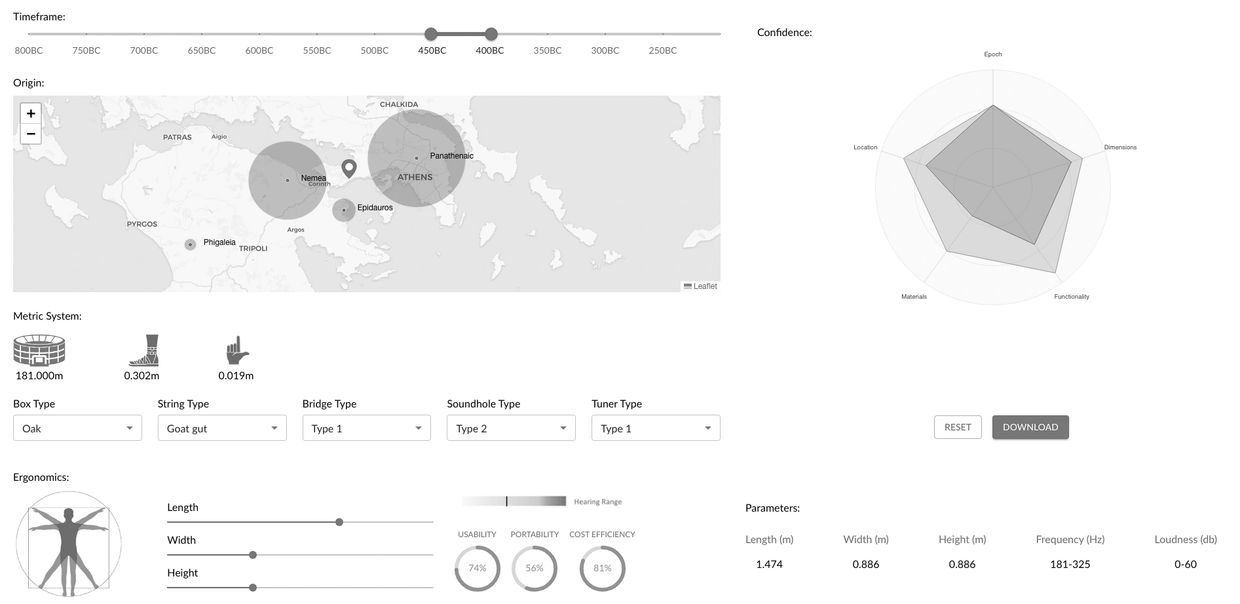
Under the Hood
Additional Information
Cloud Management Setup:
kanON is a gamified web application (compatible with multiple browsers) that was developed as a readily available EdTech tool. In order to ensure interoperability and meet industry-led standards, it currently resides on AWS Elastic Container Services, with the data being migrated to a unified cloud management console to support Online Analytical Processing (OLAP). The GUI was built upon Matlab integration (Cadlab toolbox) thereby allowing for user-controlled parametrization and scenario (what-if) analyses on-demand. The backend configuration provides seamless integration and lays out the groundwork for real-time stochastic and probabilistic modeling (with little, or no, programming skill) by employing automated Machine Learning (autoML) at two distinct levels:
Tier I: Lazy Learning
By specifying some initial time range (using the main slider), certain centroids pop up on the Geomap, representing the Classical Stadia (stadiums), where Greek footraces used to take place at the time. Their very existence (together with their corresponding radii of cultural influence) vary with time, based on historical evidence. At different timeframes, the proximities of the user-dropped pin to the stadiums (GPS coordinates) are used as reference to make predictions about its grouping, by employing a fuzzy k-Nearest Neighbor algorithm (assigning degrees of membership to all existent classes). These assignments are then used to restrict the remaining parameters in each scenario, using fast and frugal heuristics; e.g., selecting only eligible materials (that could be found in the wider region during that period), or giving those materials a greater probability of being selected. Another important consideration is the teleon (perfect) numerical partition scheme induced by the presumed influencing stadium, which directly affects the acceptable dimension ratios. Although a single common metric system was known to be used across all Ancient Greece, relative proportions for measuring length such as daktylos (thumb) or pous (foot) are essentially taken to be proper divisors of individual stadion (stadium) variants, resulting in slight subdivision differences. All these are reckoned with usability/portability constraints, as well as the Greeks’ notorious passion for efficiency and flair for minimalistic design (avoiding extremities) best captured in the famous quote “Metron Ariston (moderation is best)” which was attributed to Cleovoulos (6th century BC).
Tier II: Expert (Rule-based) System
Finally, our model incorporates a significant amount of domain knowledge, provided from a team of leading experts in various fields (archaeologists, historians, mathematicians, mechanical engineers, musicologists, etc.) by the means of self-reported surveying and focus group discussions. Subjective judgements were codified and relevant qualitative data patterns were extracted based on the comprehensive taxonomy proposed by the ERA Chair guidelines on DCH Knowledge Management. Natural language responses have undergone text normalization (stemming and lemmatization) for lexical analysis, while the corpus was methodically examined looking out (scanning) for frequent mentions of keywords assumed to reflect core concepts. Participants also engaged in a series of targeted pairwise comparisons (Analytical Hierarchy Process) to rate and/or aggregate alternatives for quantification purposes. On second level, the model utilises Dempster-Shafer theory of belief functions to combine and propagate conditional probability ranges (retrieving upper and lower bounds from expert responses) in the form of declarative (production) rules that come with certainty factors. As a result, a conclusive educated guess (a pilot 3D file) was designed via part-assembly software (Solidworks), drawing inferences directly from the all-encompassing knowledge base. This way, any user-generated solution can be contrasted against the hidden (optimized) version obtained by the algorithm, while quantifying comparable measures of confidence for individual characteristics (such as location, epoch, materials, etc.) ceteris paribus.
How to Use
Origins
Parameter Setting
Parameter Setting
Use the slider and the pin on the Geomap to formalize hypotheses about time and place.
Parameter Setting
Parameter Setting
Parameter Setting
Use dropdowns and sliders to help you determine the proposed materials and dimensions.
Model Confidence
Real-time Rendering
Real-time Rendering
View the corresponding confidence scores of your model against our own using the Spider Chart.
Real-time Rendering
Real-time Rendering
Real-time Rendering
Use the download button to export your model as a flattened image or an interactive 3D object.
Copyright © 2023 kanON - All Rights Reserved.
Powered by GoDaddy
